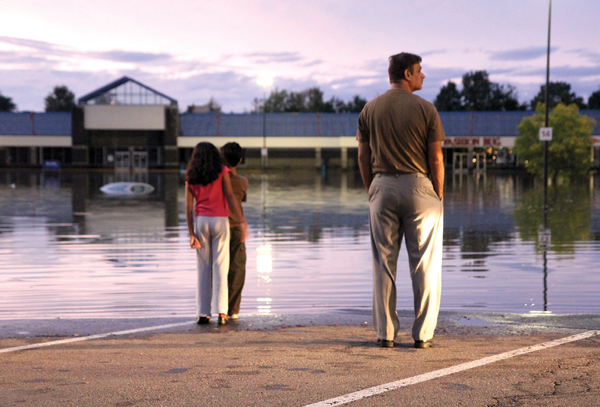
Six months after floods brought on by Tropical Storm Lee ravaged the Southern Tier — with $1 billion in damage in Broome and Tioga Counties — government officials, local organizations and Binghamton University student groups are still working to recover from the flood and figuring out how to pay for it.
The flood caused $513 million in damage in Broome County alone.
GOVERNMENT EFFORTS
Broome County Executive Debra Preston, who came into office after the flood, said she is lobbying for support.
“We are working with all levels of government to provide the maximum amount of funding to aid the recovery of our residents and businesses,” Preston wrote in an email to Pipe Dream.
The funds for local repair are being allocated to areas with the most damage, according to Preston.
“Earlier this month I announced $500,000 available through the county to assist businesses with an unmet need for repairs,” Preston said. “Recently the State announced an additional $30mil [sic] to further assist those hardest hit, and the county is fighting for every penny of those funds.”
Preston said both she and Sen. Charles Schumer (D-NY) have pressured the federal government to sustain the funding to prevent severe flood damage in the future.
“Sen. Chuck Schumer and I demanded the federal government continue to fund flood gauges on rivers and streams, to signal evacuations and notify us of water levels,” Preston said.
Local officials, business owners and the public were invited to attend a Flood Mitigation Workshop, hosted by the Broome County Department of Planning and Economic Development. The workshops were held to discuss the impact of future flooding, according to Preston.
“We’ve encouraged flood victims to use local contractors with a history of quality work in our community, to lessen the potential for scams,” Preston said. “We will continue these efforts until Broome County is rebuilt.”
According to Dennis Michalski, spokesman for the state’s Emergency Management Office, FEMA has been working “aggressively” to help New York residents recover from Hurricane Irene and Tropical Storm Lee.
“As of [Monday] FEMA has approved more than $154 million to individuals for both disasters,” Michalski wrote in an email. “There have been 61,133 registrations for FEMA aid. That covers housing assistance, repairs and unmet needs. The SBA [U.S. Small Business Association] has approved $131 million for low-interest loans for both events.”
Michalski said that as of Monday, Broome County has 6,175 eligible applicants who have received more than $34.4 million in assistance under the Individuals and Households program.
HABITAT FOR HUMANITY
Sherry Liao, secretary of Binghamton University’s Habitat for Humanity (HFH), said the group collaborated with Broome County Habitat for Humanity and the First Presbyterian Church in cleanups. The group helped to tear up walls and foundations, recover items from flooded basements and hose down the insides of houses, among other tasks. The club took groups of about 10 volunteers on each of the cleanups.
Joseph Garrant, treasurer of BU’s HFH and a sophomore majoring in economics, said there is still plenty of work to be done.
“Many of the homes that have been cleared out to the bare frame, now need to be rebuilt from scratch,” Garrant said. “There are several opportunities for students to help out with this ongoing recovery.”
Garrant also participated in the flood relief internship program offered at BU, a class and service program taught by Allison Alden, assistant professor in the public administration department and Donald Loewen, Russian department chair and associate professor.
Garrant said the class was split into six seminar sessions covering a variety of issues including the psychological impacts of natural disasters, socio-economic implications of the 2011 flood, emergency response and recovery. The students were required to perform at least 30 hours of volunteer service for flood relief efforts.
“I found this class to be very informative,” Garrant said. “I found the service part of the class very rewarding. It was eye-opening to see all of the people who were struggling as a result of the flooding. Some of the guest speakers overlapped the information they talked about, but other than that the class was great. The class helped me to get more involved in flood relief efforts and learn more about ways that other people can help out.”
Alden, director of BU’s Center for Civic Engagement (CCE), said there are fundraisers held across the community and dozens of ongoing projects to aid flood relief.
“Students can sign up for the Center for Civic Engagement newsletter that sends out weekly updates,” Alden said. “There is a flood relief page on the CCE website that changes regularly with updates.”
The CCE will soon announce a partial scholarship for students to lead their peers in flood relief efforts.
Alden said students can also get involved by participating in this year’s alternative spring break where volunteers would stay Binghamton and help rebuild local homes.
“It’s great to see students with such commitment,” Alden said. “[It is] wonderful we have such caring students.”
Andrew Block, executive assistant to the mayor, said he is pleased with the recovery efforts.
“This work is difficult for everyone involved, but it’s also absolutely necessary,” Block wrote in an email. “We’re proud of the progress we’re making and we expect to emerge from this challenging time stronger than ever.”


